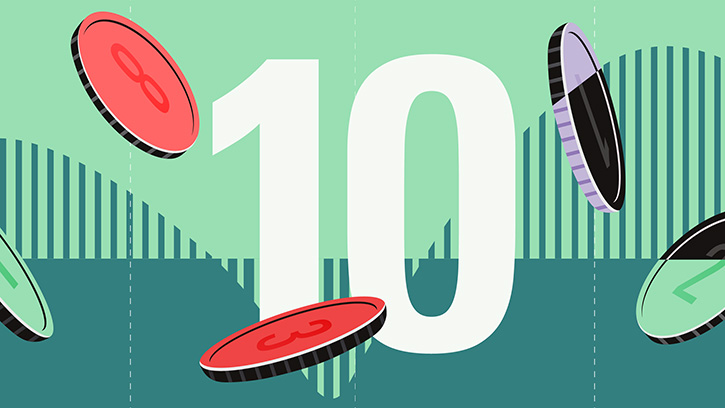
As the new year begins and we move closer to potential interest rate hikes amidst inflation and valuation concerns, investors might be worried about where to find income in 2022. However, the sentiment for the year ahead appears to be strong.
“Corporate profitability has improved dramatically in 2021 and should continue to improve in 2022. We believe that as we emerge from pandemic-driven supply chain challenges, strong demand for manufactured goods and inventory replenishment should exist. Dividend growth for the TSX has historically been 5% and this environment should support dividend growth in line with this historical average,” said Steve Arpin, managing director of Canadian equities at Beutel Goodman Investment Counsel.
To him, the key drivers of sustained dividend growth are corporate profitability and free cash flow generation. “With the earnings recovery in 2021 and an expected positive backdrop for these factors in 2022, we expect dividend growth at least in line with the historical average,” he reiterates.
The growth in dividends seems to have started already, as Canadian investors got one final dividend boost in the last quarter.
Banking on Canadian Banks
Canadian Banks came through (and how) on their promises of both dividends and buybacks. The highest was by BMO, with a dividend announcement of 25%. The lowest was CIBC, with a 10.3% dividend announcement.
Can they keep it up? We think they can.
“The banks and life insurers only recently received permission from OSFI to raise their dividends (as, hopefully, the worst of the pandemic is behind us). They have all raised their dividends and some banks did suggest that they could look at another dividend raise mid-2022. Current yields are pretty attractive at 3.6% (Royal Bank of Canada) to 5.6% (Manulife Financial Corp),” said Bill Dye, head of equities for Leith Wheeler.
He points to one factor that could impact the banks in 2022 – the likelihood of having the Federal government increase taxes on this sector (as well as the largest life insurers). “Details will come out in the Spring 2022 Budget, but presumably the banks and life insurance companies are being a bit conservative in terms of their dividend payout ratios until they know the details of the tax bill,” Dye noted.
“Banks retain excess capital, and at the very least we believe the group will resume their annual pattern of increases from this point,” agreed Les Stelmach, SVP and portfolio manager, Franklin Templeton Canada.
Arpin also continues to view Canadian banks as being in a strong position to grow earnings and dividends given their strong capital levels and broadly favourable outlooks. “With the recent increases in dividends, the banks are now all within their targeted payout ratios based on trailing earnings (40-50%),” he said.
Dividends Beyond Banks
But looking beyond banks and insurers as well, some think 2022 might be a bumper year for dividends in Canada.
Stelmach expects that 2022 should feature a “catch-up” in dividends relative to 2020 and 2021 for a few reasons, apart from the bank increases.
“We have seen a remarkable recovery in oil prices following a precipitous drop in the spring of 2020 at the onset of COVID. Back then, a number of energy stocks were forced to cut dividends, as the depth and duration of the economic downturn were unknown. Since then, the oil & gas sector has staged a remarkable recovery, with higher crude oil and natural gas prices boosting cash flows. Of those that cut, many energy companies have since restored prior dividend levels, and some are distributing at a higher rate than they had prior,” Stelmach says.
Another space on which Stelmach is keeping an eye is real estate, which he thinks should also be a source of higher than average income growth. “Real Estate Investment Trusts (REITs) in certain property categories, primarily retail, had to absorb higher vacancies and deferred rent payments from tenants as stores were temporarily closed. These stresses often manifested in flat cash distribution profiles or, in some cases, temporary reduction in distributions. Although it is too early to say that things will return to historical norms across all property classes, we are seeing encouraging signs in rents and occupancy, and note some REITs are again raising distributions,” he said.
He also thinks that other sectors, utilities and telecom, for example, remain “Steady Eddies” as it relates to dividends, and expects dividend growth trajectories in line with historical experience.
2022 Forecasts: Stocks and Sectors in Focus
“The key dividend driver is growth in earnings per share (EPS). Many of the financials target payout ratios of 40-50% of EPS so as EPS move up, dividends are raised. The resource companies tend to keep their dividend payouts low in case commodity prices turn down, but sometimes pay special dividends when commodity prices turn up (but may not appear to be sustainable),” Dye says. Obviously, a move back towards more shutdowns due to the Omicron variant would impact EPS growth and therefore dividend growth.
To Arpin, the key risks to dividends are high payout ratios and collapsing corporate profitability. “Companies with payout ratios above 70% should be examined closely to review if they can maintain their dividends while continuing to reinvest appropriately in their business. Economic weakness (low or declining GDP growth) will put more cyclical businesses at greater risk for a dividend reduction,” he said.
Stelmach agrees that risks to dividends vary with the different businesses involved, and should rising COIVD case numbers require more restrictive lockdowns, this could impact demand for energy and/or reduce consumer activity, which would be an obvious negative. “Higher inflation could act as a drag, but for the most part the areas of the market we are focusing on either have the ability to pass-through cost inflation (REITs, utilities, telecom) or have products whose product sales prices are correlated with inflation (commodities),” he said.
In terms of stocks, he has a favourable view on energy and financials. Within energy, he thinks investors should stick to high quality companies with strong financial underpinnings like ARC Resources, Suncor Energy and Enbridge, which have all raised dividends recently. “ARC recently increased its dividend by 50% while at the same time executing on a buyback program of 10% of its outstanding shares. Similarly, Suncor has restored its dividend to its pre-COVID level, and despite some stronger momentum of late, has lagged some of its other large cap peers. Within the banks, while we believe the group in general is attractive, we would single out RBC, which has a been a recent laggard, but is attractive on our valuation work. In Information Technology, we prefer Open Text Corp, which looks attractive to us, with rising cash flows and dividends and an inexpensive valuation,” Stelmach said.
Morningstar Stock List
Of the stocks in Morningstar’s coverage universe, these are the 10 with the highest forward dividend yield:
|
Name |
Economic Moat |
Morningstar Star Rating |
YTD Dividend |
Forward Dividend Yield % |
YTD Returns |
|
Narrow |
3 |
3.34 |
7.20 |
25.55 |
|
|
None |
3 |
1.76 |
6.90 |
30.06 |
|
|
None |
3 |
2.52 |
6.62 |
34.12 |
|
|
Narrow |
4 |
3.48 |
5.91 |
18.84 |
|
|
Narrow |
3 |
3.50 |
5.33 |
27.12 |
|
|
None |
3 |
1.80 |
5.29 |
27.95 |
|
|
Narrow |
3 |
2.25 |
4.99 |
35.66 |
|
|
None |
3 |
1.17 |
4.83 |
7.51 |
|
|
None |
3 |
1.84 |
4.69 |
49.00 |
|
|
Narrow |
3 |
4.60 |
4.61 |
31.44 |
Source: Morningstar Direct Data as of December 21, 2020
The top four are in oil and gas, while the bottom five are in financial services. The only stock that is from outside these two sectors is telecom giant, BCE. Of the list, three stocks have a forward dividend yield of more than 6.5%. Let’s look at those in some detail.
First up, is Enbridge, with a forward dividend yield of 7.2%, the highest in our Canadian coverage universe. Morningstar analyst Stephen Ellis awards the company a capital allocation rating of ‘Standard’. The capital allocation rating focuses on balance sheet strength, investments made, and shareholder distributions all of which are inputs for total shareholder return.
“In our view, the company maintains a sound balance sheet, with leverage in the target range of 4.5-5.0 times EBITDA. We expect the balance sheet to improve, as the company’s growth portfolio is poised to generate incremental cash flow that will be directed toward paying down debt, increasing the dividend, investing in high-return projects, and possibly buy back shares if conditions warrant. With the balance sheet on a positive path, and investments likely more restrained going forward, Enbridge has taken an appropriate stance on its prized dividend. The company has been prudent with dividend increases and has identified up to $2 billion annually under its current capital spending program that can be allocated toward increased capital returns to shareholders, providing a very healthy margin of dividend support and safety,” Ellis explains.
The second highest forward dividend yield in our coverage universe is Keyera Corp, at 6.9%, and a ‘Standard’ capital allocation rating. “Keyera pays a significant dividend to its shareholders, and we believe that this is the most appropriate way to return cash to shareholders. Following the pandemic, we expect the company to be judicious with future increases after it prioritizes the Key Access Pipeline System growth project and pays down debt,” Ellis says.
The third is Pembina Pipeline, which earns a capital allocation rating of ‘Poor’ and has a forward dividend yield of 6.62%. Ellis’ ‘Poor’ rating is because Pembina’s has largely relied on growth-by-acquisition to expand to new markets and product offerings and offering new bolt-on opportunities to existing assets. “While we’d consider the overall asset quality of the firm to be solid, the returns on these investments have been at best challenged with significant assets already in decline and key projects effectively canceled,” he said. However, he adds that, “The biggest plus, in our view, is Pembina’s dividend policy, which was ahead of many U.S. peers by years in terms of boosting its coverage ratio. As a result, Pembina should operate around break-even this year on a free cash flow after dividend basis and begin to generate material excess cash flows in 2022, without having to engage in massive dividend cuts like many U.S. peers.”























